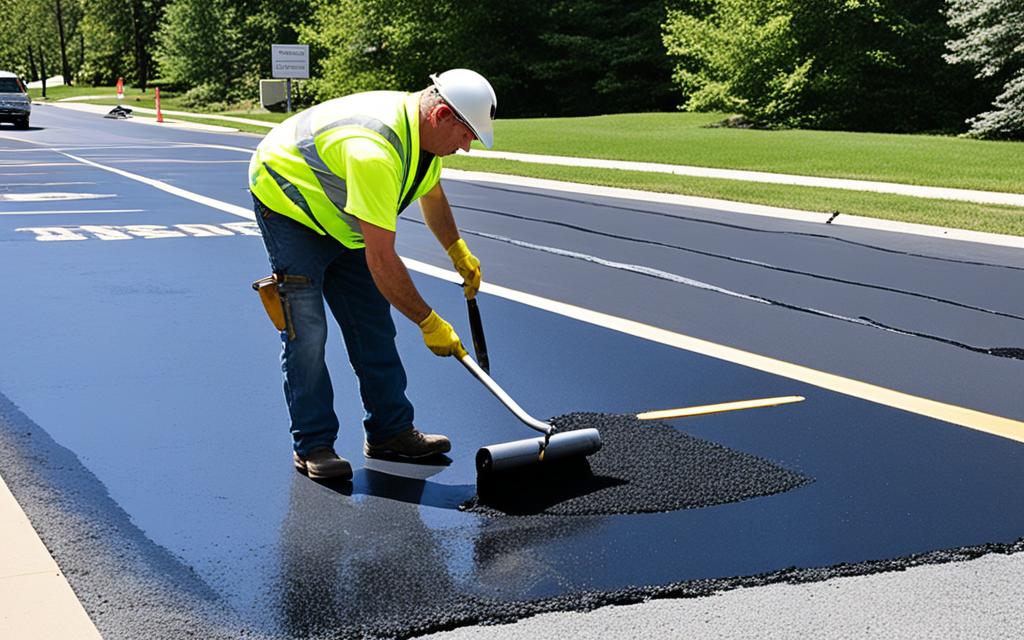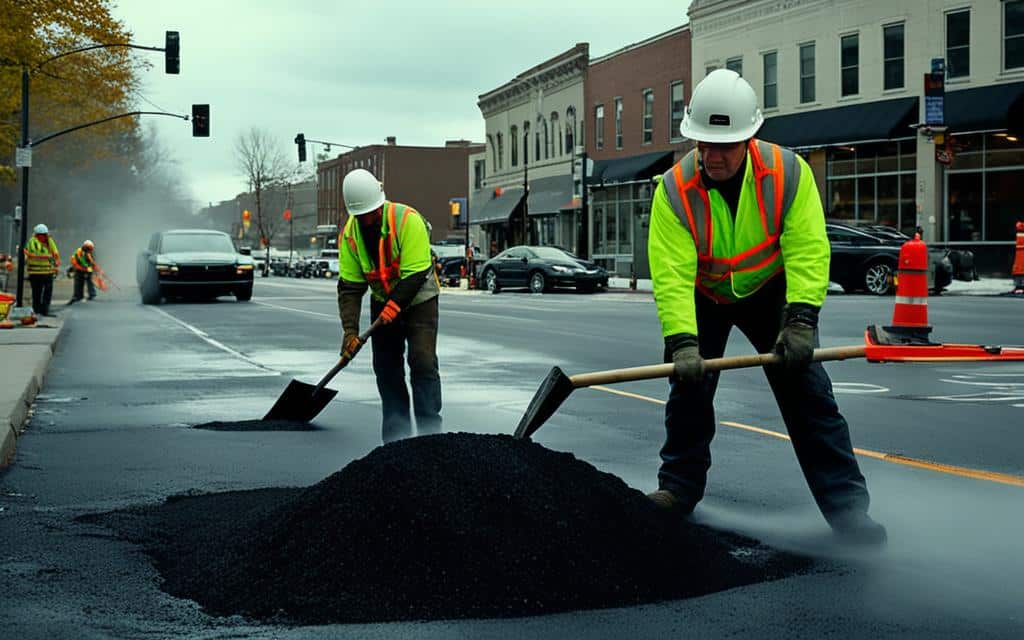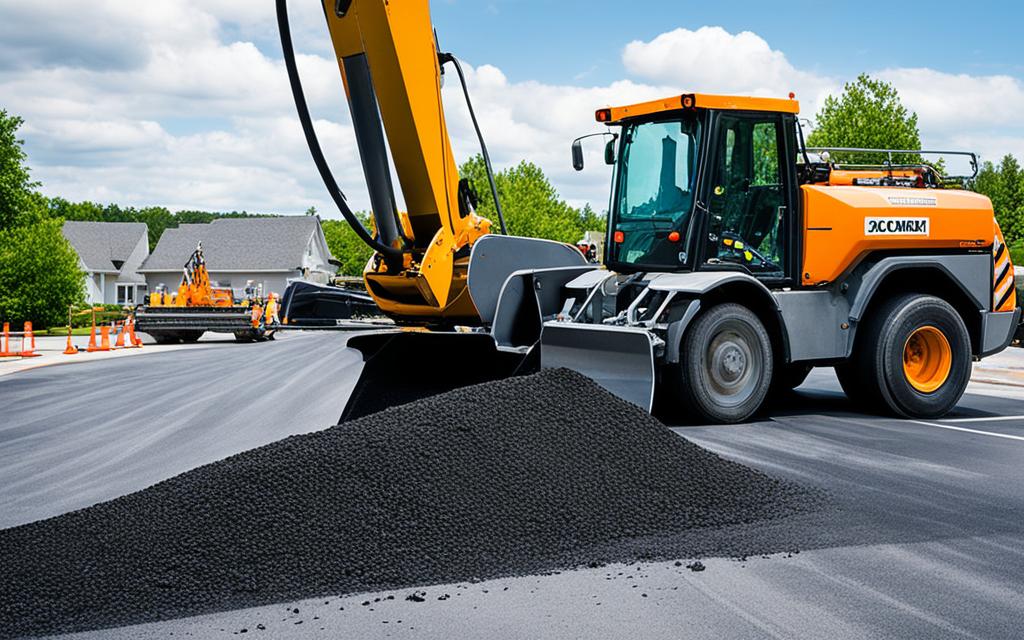Have you heard of asphalt sealcoating and overlay for maintenance? But, what’s the real difference? And which one is better for keeping your driveway or parking lot safe?
Sealcoating seems to just look good. But, does it really keep your asphalt safe for the long run? Overlay, on the other hand, might fix things quickly but not forever. So, what’s the deal?
In this piece, we’ll dive into asphalt care. We’ll look into how sealcoating and overlay are different. And most importantly, we’ll help you make smart choices for your pavement’s protection.
Key Takeaways:
- Sealcoating protects your pavement from the sun, rain, and leaks from cars.
- Overlay is used to patch up cracks and holes, but it’s not a lasting solution.
- Sealcoating needs to be redone every 1 to 3 years to keep working well.
- An overlay won’t last forever, and the same issues might come back in a year or two.
- Choosing the right care method is key to keeping your asphalt in good shape.
- HT Paving can help you take the best decision. Call us now at (415) 774-6424
Benefits of Asphalt Sealcoating
Asphalt sealcoating has many perks for keeping your pavement and driveway looking good. Its rich black color makes your pavement seem new. This improves how your property looks.
But, asphalt sealcoating does more than make things pretty. It acts as a shield, protecting your pavement from the sun, rain, and car fluids. These things can harm the asphalt, leading to cracks and holes.
Putting on a sealcoat creates a shield, keeping water and chemicals away. This extends your pavement’s life. It stops water from getting in and causing harm. Plus, it lowers the risk of damage from car substances.
Sealcoating also helps by filling in small cracks and flaws in the pavement. Asphalt can get these cracks from everyday use, weather, and moisture. Sealcoating prevents these cracks from getting bigger and causing more damage.
It makes the surface smoother for walking and driving. A new sealcoat gets rid of small bumps, making it safer and easier to use driveways and parking lots.
It’s best to get asphalt sealcoating done within 1 to 3 years of putting in your pavement. Doing it during this time lets the new pavement completely set. This means you get the most out of its protection.
Preserving Your Pavement for the Future
Asphalt sealcoating is essential for keeping your pavement in great shape. It boosts how your pavement looks and guards it against the sun, rain, and car fluids. By smoothing out the surface and fixing small cracks, sealcoating makes your pavement last longer and stay in good condition.
Knowing the benefits of asphalt sealcoating helps you keep your pavement in top shape for years.
When to Consider Asphalt Overlay
Asphalt overlay can be great if your pavement has cracks and potholes. It helps fix the surface, making it look and work better. But, remember, it’s not a permanent fix. The cracks and potholes might come back over time, needing more fixes.
If your pavement is getting old but doesn’t need replacing entirely, consider overlay. It’s a budget-friendly way to refresh your surface. This allows you to wait before doing a big renovation.
Before putting on an overlay, fix any cracks and potholes. This makes the surface smoother and stronger. It extends the life of the overlay by dealing with deeper issues first.
Conclusion
Asphalt sealcoating and overlay are key for keeping asphalt pavements in good shape. Sealcoating protects the surface from the sun, rain, and oils from cars. This can make your pavement last longer. It’s smart to sealcoat every 1 to 3 years.
Overlay is used to fix problems like cracks and potholes. It’s like a band-aid, helping the pavement look and function better. But, remember, an overlay is not permanent. It might need fixing again in a year or two.
If you’re thinking about overlay, fix any big cracks or potholes first. If the pavement is really old, getting a new one might be better. Understanding sealcoating and overlay can help you take good care of your asphalt. This way, your pavement stays strong for a long time.
Need more information? Contact us and get you free estimate!
FAQ
What is the difference between asphalt sealcoating and overlay?
Sealcoating protects asphalt from UV rays, rain, and car fluids. It’s like a fresh coat of paint. You should do it every 1 to 3 years. Overlay, however, covers up cracked or potholed pavement. It’s a quick fix that might not last long.
What are the benefits of asphalt sealcoating?
Asphalt sealcoating makes your pavement look black and new. It protects from the sun, rain, and car fluids. This helps it last longer. Sealcoating also fills small cracks and gives a smooth surface. It’s best done within 1 to 3 years of paving for maximum effect.
When should I consider asphalt overlay?
Overlay is good for roads with cracks and potholes. It’s a short-term fix. But, cracks and potholes might come back soon. Use overlay when a full replacement isn’t needed yet. Smooth out any big cracks or holes before overlaying for a better result.
What is the importance of asphalt sealcoating and overlay?
Both sealcoating and overlay help maintain asphalt pavement. Sealcoating protects from the weather and car damage. It extends the pavement’s life. Overlay is a temporary fix for cracks and potholes. Know when to use sealcoating or overlay to take care of your pavement smartly.






